Eduard 1/48 Bf-109G-2
The Bf-109G in Finnish Service:
During the Winter War of 1939-40, Finland obtained 24 Brewster B-239 fighters, which were the first completely-modern fighters to equip the air force. These were U.S. Navy F2A-1s, and became the first-line fighter after the end of the war in March 1940. Finland joined with Germany in attacking the Soviet Union on June 22, 1941, in what the Finns called The Continuation War and saw as an attempt to regain the territory that had been sacrificed in the peace treaty that concluded the Winter War.
The Red Air Force in the northern regions where the Finns operated was primarily equipped with I-152 and I-153 biplane fighters and I-16 monoplanes. The Soviets would operate the I-153 and I-16 in front line fighter roles in this region as late as the summer of 1943, though Lagg-3 and Yak-1 and Yak-7 fighters began appearing in late 1942. While almost always outnumbered, the Finnish Brewsters were technically superior to their opponents; when combined with pilots who had superior training, they maintained air superiority over their part of the front, with the B-239s eventually scoring 0ver 400 victories by the time Finland was forced to capitulate in September 1944.
The Finns had tried as early as 1938 to obtain first-line fighters from Germany, but had been refused. Even after going to war as Germany's ally, they were only able to obtain German war booty in the form of Curtiss H-75A-3 “Hawk” fighters taken over from France, for which they had to pay a”market” price! In December 1942, an agreement was reached to supply 30 first-line Bf-109G-2 fighters to equip one fighter wing, with the Germans agreeing to supply replacements for losses. The agreement was signed February 1, 1943. The aircraft were supplied in two batches, 14 brand-new Bf-109G-2s that arrived March 13 and 16 completely-overhauled ex-Luftwaffe G-2s that arrived on May 10.
Lentolaivue (LeLv) 34 was formed as a new fighter regiment to operate the Bf-109G-2s. Most personnel came from LeLv 24, the premier Finnish fighter unit equipped with B-239s and including many of the leading aces. Pilots had gone to Germany for training in the Bf-109 prior to joining the unit. Major Olavi Ehrenrooth was the first CO, but was killed in a flying accident on March 27, 1943. Major Eino Luukanen assumed command, and would remain LeLv 34 CO until the end of the war.
The Messerschmitts first made their presence known to the Red Air Force on March 24, 1943, when Warrant Officer Ilmari Juutilanen shot down a Pe-2 over the Estonian coast. It was the first of an eventual 58 victories Juutilanen would score while flying the Bf-109, atop 36 victories scored in the Fokker D.XXI during the Winter War and with the B-239 in the Continuation War, making him the Finnish Ace of Aces with 94 victories.
The Finns generally operated their Bf-109s in flights of two or four, to intercept Soviet aircraft over the front lines and to protect Helsinki from bombing raids. There were larger battles, with the first of these coming May 20, when five Bf-109s led by Captain Olli Puhakka engaged 23 Soviet fighters, shooting down one I-16 and one Yak-1, while Lt. Paavo Myllyla with four Bf-109s intercepted 12 I-153 Chaikas and shot down two. Though the Chaika was technically outclassed by the Bf-109 in almost all categories, its pilots would give the Finnish 109 pilots difficulty throughout the period of the Chaika's remaining service because of its agile maneuverability.
On May 21, Major Luukanen led 11 Bf-109s to intercept four Il-2s escorted by 17 Lagg-3s and La-5s. 16 B-239s and 12 German-flown Fw-190s from JG 54 joined in the fight. Luukanen's force scored two Il-2s, two Lagg-3s and two La-5s before the five Soviet survivors fled the scene of battle. Similar battles were fought over the Karelian peninsula for the rest of 1943, with the Finns consistently out-scoring their Soviet opponents.
By early 1944, the Finns were down to thirteen operational Bf-109s, despite German replacements which had provided a total of 48 Bf-109G-2s. A new agreement was concluded on March 15, 1944, to provide another 30 Bf-109G-6 fighters, thus allowing the Finns to equip two fighter regiments with Messerschmitts. 15 of the Bf-109G-6s arrived by March 18, allowing LeLv 34 to transfer their surviving Bf-109G-2s to the B-239-equipped LeLv 24, which in turn passed their 15 surviving B-239s on to LeLv 26. The Finnish State Aircraft Factory had managed to re-build several damaged Bf-109G-2s by replacing damaged parts of one with undamaged parts of another, so that LeLv 24 had 18 Bf-109G-2s by the time the Soviet offensive began on June 9, 1944, that would finally push Finland out of the war within 90 days.
Fighting over the front during the summer of 1944 against the Soviet offensive was an almost-daily affair for both Bf-109-equipped units. For instance, on June 10, Lt. Sarjamo led 4 Bf-109G-2s of 2/HleLv 24 against 10 Pe-2s escorted by 60 Yak and Lavochkin fighters, shooting down three Pe-2s before diving away from the escorts. Later that day, Captain Jouko Myllymaki led his flight of four Bf-109G-2s against a Soviet formation of 36 Pe-2s escorted by over 40 La-5s, shooting down three Pe-2s and two La-5s, again for no losses by the Finns.
On June 19, LeLv 24 received eight new Bf-109G-6s to the third flight, while LeLv 34 received six to make good losses.
Throughout June and July, the Messerschmitts attacked Soviet formations over the front, with particularly difficult battles over Viipuri-Tali area. One particularly large engagement on June 28 saw a flight led by Captain Hans Wind of LeLv 24 lead 11 Bf-109s against 20 Il-2s and 20 Pe-2s that were attacking Finnish positions, shooting down eight Il-2s, two Pe-2s and an escorting La-5, while that afternoon Captain Puhakka of 3/HleLv 34 intercepted 60 Il-2s escorted by 40 fighters; Lt. Puro of 2/HleLv 24 arrived with 8 Bf-109G-2s and in the ensuing air battle the Soviets lost six IL-2s, two Yak-3s, two Yak-9s and one P-39 Airacobra. In all on that one day, HleLv 24 scored 33 victories while HleLv 34 scored another 10, all without loss, though a wound suffered by Captain Hans Wind put him out of action for the remainder of the war.
During the Soviet offensive, which lasted 38 days, The Finnish Bf-109s and B-239s claimed 425 Soviet aircraft destroyed and another 78 damaged, while the Fw-190s of II/JG 54 led by Major Erich Rudorffer scored a further 126 victories.
The last victories of the Continuation War came on August 8, 1944, when Major Luukanen's four Bf-109G-6s intercepted six Il-2s escorted by six Yak-9s, shooting down on Il-2 and two Yak-9s. The truce was signed on September 4, 1944. Finland maintained its independence by confirming the border created by the Winter War, with additional territory ceded from northeastern Finland.
HleLv 34 scored a total of 345 victories on Bf-109s, losing 13 aircraft in air-to-air combat and five to anti-aircraft fire, with 12 pilots killed and one becoming a POW. HLeLv24 had scored 300 victories while flying the Bf-109 in the last six months of the conflict, losing 12 109s in combat and two in an air raid, with 9 pilots killed and one becoming a POW. Total Bf-109 victories - including 3 by HLeLv30 and 15 by HleLv 28 right at the end - was 663 for a total loss of 24, a victory ratio of 25-1.
Of 162 Bf-109Gs supplied during the war, the Finns had 102 available at the end. The Paris Agreement of 1947 limited them to 60 front-line fighters, with the rest put into storage and used for attrition. 41 aircraft were destroyed or damaged beyond repair in post-war service, with the last flight being made by Lt. Col. Erkki Heinila on March 13, 1954, to commemorate the 11th anniversary of the Bf-109's arrival in Finland.
1st Lt. Kalevi “Kale” Tervo:
The 15th-ranked Finnish pilot of the Continuation War, Lieutenant Tervo scored a shared victory flying the Brewster B-239 in HLeLv24. He was the top-scoring Hawk 75 pilot of the war (on either side), scoring 15.5 victories in a Hawk 75A-3 with HLeLv32. In 1943 he transferred to HLeLv34 to fly the newly-acquired Bf-109G-2, where he scored 7 victories before being killed in combat on May 17, 1943.
THE KIT
The Bf-109G-2 is the second major sub-type of the Bf-109G released by Eduard. For any modeler familiar with the Bf-109F-4 or Bf-109g-6 kits, this kit offers no surprises, being equal in quality to these excellent predecessors. The kit includes two complete wings, one with the wheel well bulges found on late-production and repaired Bf-109G-2s, and the original smooth wing. (If you have the earlier, incorrect, Bf-109G-6 kit, you can easily substitute the wing option with the wheel well bulge and create a model that is substantially corrected.)
The kit provides decals for five different aircraft with interesting camouflage and markings.
I opted to use the SBS Model decals to do a Finnish Bf-109G-2. SBS Models have been primarily known for excellent resin correction and update sets, and have ventured into decals with the goal of doing air forces and units that have not been “done to death.” These are excellent decals, with color markings profiles and are well-researched. This sheet provides full markings (including national insignia) for four different Bf-109G-2s that have not been done before by any decal company.
Construction of the Eduard 109s is easy. Follow the instructions, paying attention to any sub-type equipment differences (which the instructions will note). The result is an easy assembly and a good-looking model.
I started with the cockpit, painting everything before assembly, then assembling the cockpit per the instructions. I finished off by assembling and attaching the photo-etch instrument panel and the seatbelts.
This was followed by assembling the fuselage as a sub-assembly, and the wings as a sub-assembly. Everything fits with care on the part of the modeler, and I did not use any filler anywhere.
After preshading the panel lines, I applied the yellow markings per the detailed profile provided with the decals, then masked those off. I applied RLM76 which I mixed from Tamiya paints, then applied the RLM74 and 75 upper colors. The airplane I was modeling had been painted in the field following delivery to the Finns, and I carefully followed the profile and studied the photos I found to get the fuselage blotch camouflage. The wings and horizontal stabilizer were in standard camouflage factory paint patterns. When finished I gave the model an overall coat of clear gloss and allowed it to set up overnight.
The SBS decals are thin. They should be kept in the water until they are just ready to float off the backing sheet. Be sure there is water on the surface where they will be applied. Carefully slide them into position and blot the water with tissue paper. I applied Micro-Sol, and the decals went down perfectly. I used the kit stencil decals for the other markings. This airplane had the German upper wing crosses, painted out with what appears to be RLM02, so I applied those decals from the kit sheet, then overpainted them with Tamiya RLM Grey using a 0000 brush. When everything was set, I washed off the model to get rid of any setting solution residue, then gave the model an overall coat of clear flat.
I had found several photos of MT-207 on the internet. There did not appear to be a lot of dings, though there was exhaust staining.
I then unmasked the canopy and attached it in the open position after attaching the main gear. I attached the prop and called it finished.
It's an Eduard 109 - what's to complain about? I really like the SBS decals and will be getting them in the future for other projects. They are among the best decals I have used. Whether you go for aftermarket decals or use the excellent kit decals, the result will be a good-looking model for anyone with a few kits under their belt. Highly recommended for 109 fans.
SBS decals purchased from Scott's Model Workshop on eBay, an excellent store to deal with, providing excellent service and products you don't find everywhere else.
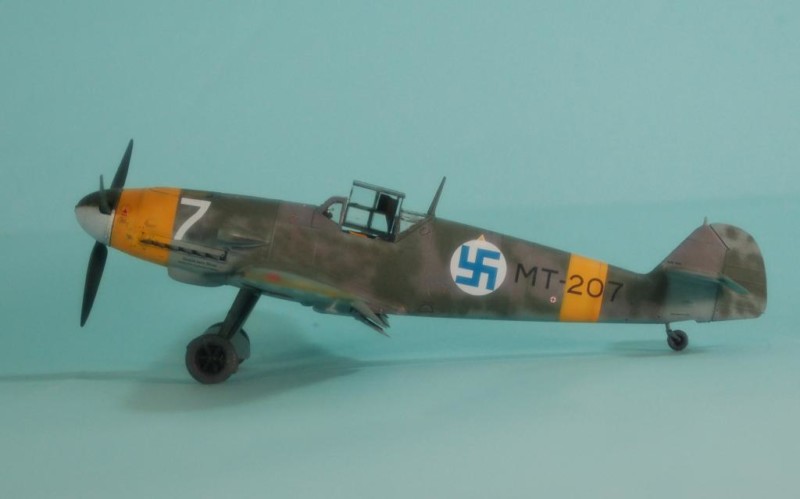
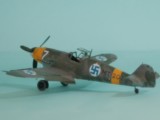
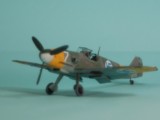
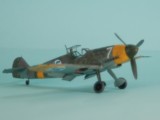
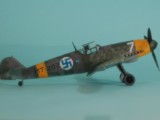
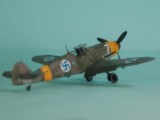
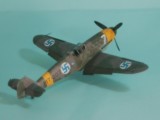
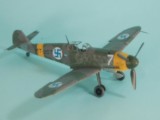
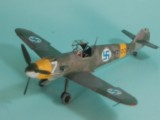
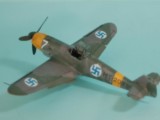
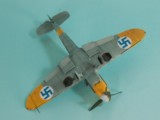
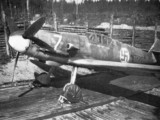
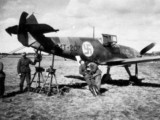
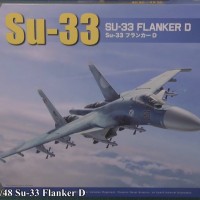
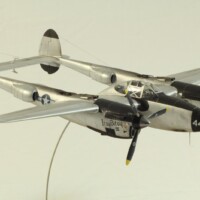
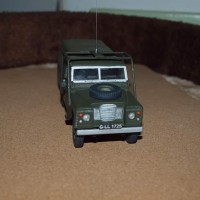
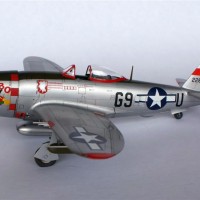
Nice finish on the Finnish, Tom...those crosses on the wings are j-u-s-t barely visible (as they were meant to be) - good work.
Love it and thanks for the heads up on SBS. I see a few more oddball schemes to be added in the future. Agree 100% with you about Scott’s Model Workshop, purchased a half dozen or so items from the site
Thank you for this nice smooth model & story. 109 is an important piece of our history in Finlandia.
Another nice one Tom. Fun to see the Finnish markings on the 109 - a different look.